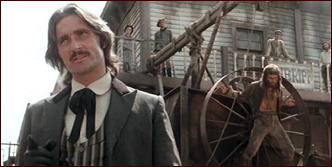Wed 26 Dec 2018
A Movie Review by Dan Stumpf: KEOMA (1976).
Posted by Steve under Reviews , Western movies[6] Comments
KEOMA. Far International Films, Italy, 1976. Also released as Django Rides Again and The Violent Breed. Franco Nero, William Berger, Olga Karlatos, Gabriela Giacobbe, and Woody Strode. Written & directed by Enzo Castellari.
One of the Great Westerns.
And I don’t mean just Spaghetti Westerns; KEOMA can stand right alongside STAGECOACH, RIDE LONSOME, THE NAKED SPUR or any other superb western you care to name, and for once I’m not kidding.
I’ll say at the start (or close to the start, anyway) that KEOMA lacks the warmth of RIO BRAVO, the intimacy of MY DARLING CLEMENTINE, and the drama of MAN OF THE WEST. But what it lacks in Heart, it shellacs with Pizzazz. KEOMA’s visual sweep and choreographed camerawork boggle the eyes and dizzy the imagination.
Also, Woody Strode gets one of the best death scenes ever in the movies.
The plot here is a timeworn thing about the lethal drifter coming up against a ruthless small-town despot. It’s also just a launching pad for writer Castellari’s mysticism and director Castellari’s rich visuals, both of which get shown off in the very first scene as Keoma (the name means “far away.â€) rides into a ghost town and talks with a witch about Destiny. The witch recalls a time when she saved Keoma as an infant, the camera pans across the ghost town, and suddenly, without apparent cutting, it has become a burned-out Indian village.
Wowsa.
I should also throw a bouquet here to Carlo Simi, who designed a Western Town that looks like the Gotham City of Tim Burton’s BATMAN: an Escher-style thing of twisting streets, half-built structures, and stairways rising to vertiginous nowheres.
And another bouquet to stunt coordinator Rocco Lerro, who populates the despot’s army with hyperkinetic stuntmen and – more important – gives them lots of neat stuff to do. There’s one manic moment when a bad guy chasing Keoma rides pell-mell down the street, grabs one of those wooden posts that holds up the awning over the sidewalk, flies off his horse, spins around the post holding on one-handed, lands on a stairway and runs up just in time to get mowed down by Woody Strode’s shotgun and go flying back down the stairs, all in a single take.
Wowsa.
In the lead role, blue-eyed Franco Nero looks a bit like Jeffrey Hunter in KING OF KINGS, all the more so when Castellari’s script gets him crucified with a nod to Shakespear’s JULIUS CAESAR. Aside from that, Nero plays to his strengths: impassivity and silence. I can’t speak with authority on the other actors except to say that everyone is adequately dubbed in the voices familiar to those of us who watched the cheap foreign films that flooded the market in those days.
Mostly though, this is a film of visuals and mystery. And as such it’s a thing of wonder and one not to be missed.


